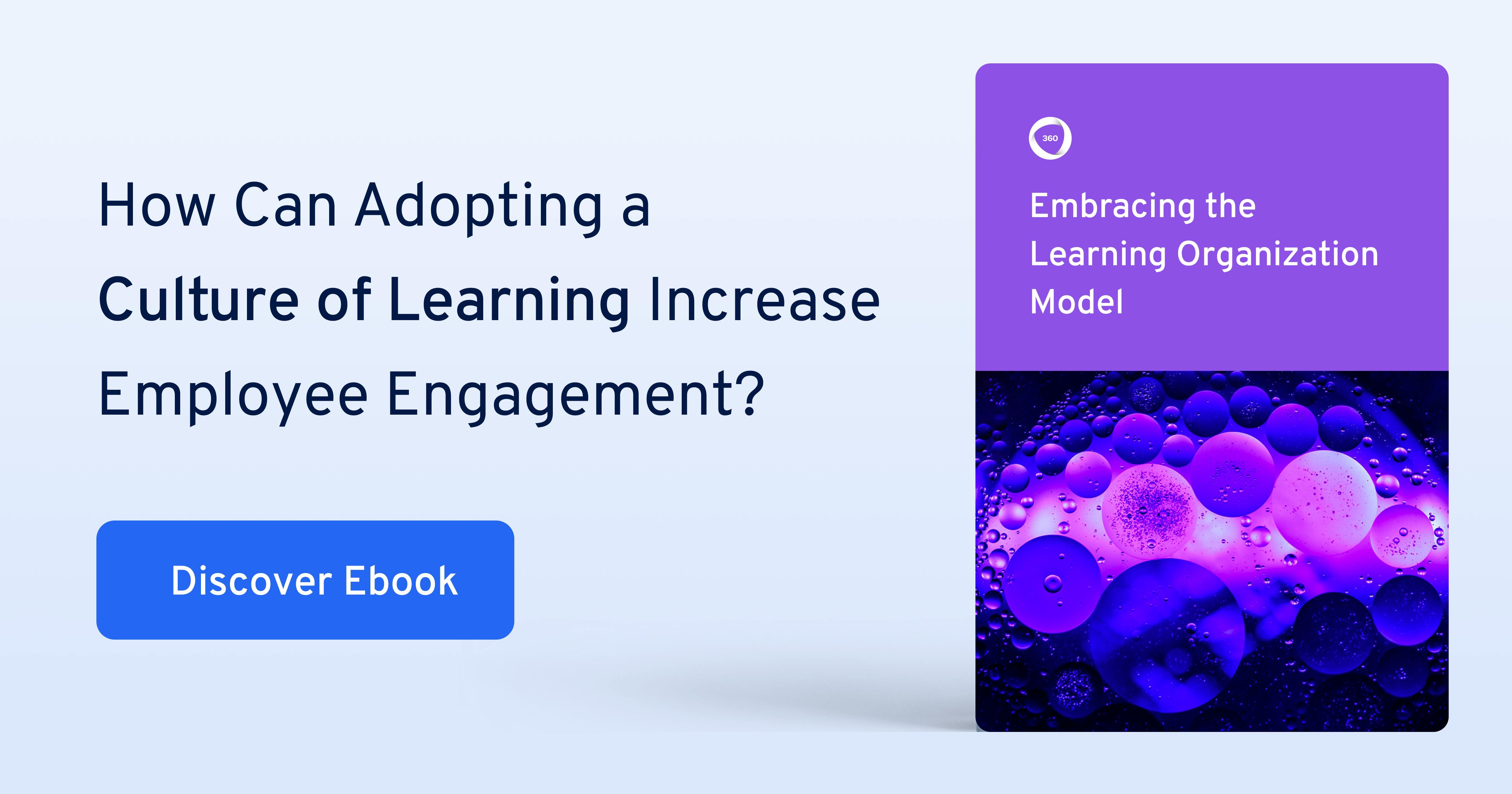The bane of L&D teams’ existence - employee disengagement - has taken on a whole new dimension this past year.
With the COVID-19 pandemic upending workplace norms the world over, Learning and Development teams have unprecedented challenges in their path when it comes to cultivating true employee engagement.
Recent polling speaks to this issue: Gallup found up to 85% of workers report some degree of workplace detachment. Couple that with the increased risk of remote burnout, and the fact that 80% of US employees’ work days have been significantly disrupted due to the pandemic, and ‘employee disengagement’ goes from a thorn in L&D teams’ side to a full-blown crisis.
Luckily, L&D teams have a viable solution right within reach: the Learning Organization model.
What is the Learning Organization model?
Simply put, the Learning Organization model is an organizational framework that relies on active and continuous learning as the foundation for an engaged and productive workforce.
A ‘Learning Organization’ is one that has embraced this model to achieve greater employee engagement, not to mention financial outcomes and customer satisfaction. General Electric and IBM are two well-known examples.
An organization’s ability to learn, and to translate that learning into action rapidly, is the ultimate competitive business advantage.
Any L&D team can leverage the Learning Organization model as an alternative to the two predominant organizational structures in use: the hierarchical and the flat.
As we’ll explore below, neither the hierarchical nor the flat structure offer the optimum level of autonomy, creativity, or growth for the average employee - pre or post-Covid. The Learning Organization model, on the other hand, supplies a ‘middle way’ between rigidity and a lack of structure.
In short, a Learning Organization:
- Is flexible and agile.
- Supports self-directed learning and continuous learning.
- Empowers employees to declare learning needs.
- Leverages knowledge of in-house experts to address those learning needs.
- Encourages human connections through Collaborative Learning.
Why you should consider adopting the Learning Organization model
If you often receive feedback that management has a heavy hand, or conversely, that there’s a lack of guidance or mentorship at work, this is a sign that you should move in the Learning Organization direction.
This is especially true in 2021: What for employees might have been a back burner disgruntlement before March 2020, could very well have mushroomed into true workplace disengagement under the pressures of the pandemic.
This is why the Learning Organization model is so valuable: since it encourages social interaction, professional development and active participation through learning, it’s particularly well-placed to succeed in the face of COVID-19.
In other words, L&Ds can deploy this model to combat remote employee burnout and provide the professional development opportunities employees crave, as a remedy to the employee disengagement crisis. Let’s explore how.
Learning Organizations support managers
The research is clear: employees crave professional development opportunities, and they are willing to leave their employer in search of them.
Just consider Gallup’s State of the American Workplace report, which shows that a lack of development and career growth is the No. 1 reason employees leave a job. Unfortunately, only four in ten US employees report having the right opportunities to learn and grow at work.
L&D teams that have embraced the Learning Organization model are well-placed to train managers to recognize and respond to this need for growth.
In Learning Organizations, employees declare a learning need, and L&Ds work with managers to create, ship and improve relevant courses. Managers get the training and necessary support to provide sorely needed professional development opportunities, and all employees achieve their growth goals.
The best part is that the framework relies on resources already found in-house - your company’s subject-matter experts.
Learning Organizations enable smooth communication
If you’re currently operating within a hierarchical model - one in which communication is top-down and all decisions, big and small, need to be validated by management - you might want to consider lobbying for a change. Here’s why:
- Communication blockages are frequent in hierarchical models, because of the top-down flow of information. Furthermore, one weak link in the ‘chain-of-command’ leaves the whole organization vulnerable.
- Management dependencies leave employees at the mercy of their direct supervisor. That’s all well and good for those lucky enough to have a great mentor, but many employees don’t feel their manager provides the right kind of guidance.
- Learning opportunities are limited, since every decision requires top-down approval. True continuous learning requires agility, and employees that are blocked at every turn won’t be able to learn at the pace of their curiosity.
Since Learning Organizations decentralize learning and empower any employee to declare a learning need or create courses, communication is freed up. Managers work with L&D teams to iterate on courses, loosening up those dependencies and multiplying learning opportunities.
Learning Organizations provide guidance
On the other end of the spectrum in terms of organizational models, many companies operate in a flat organization.
While this framework might seem like it addresses all the shortcomings of the hierarchical model, it’s not perfectly calibrated, either:
- A lack of supervision can make employees feel untethered and in search of mentorship.
- Completing one’s own work usually takes precedence over knowledge-sharing, which makes it difficult to instill a true culture of learning.
In opposition to ‘flat’ organizations, Learning Organizations champion in-house subject-matter experts to elevate their colleagues through knowledge-sharing. In this model, sharing one’s knowledge is as valued as completing one’s work. Employees also receive the mentorship and coaching through this active learning process that is often lacking in the flat structure.
5 steps to implement the Learning Organization model with Collaborative Learning
We know that shifting from one organizational structure to another probably won’t happen overnight.
However, there are some simple steps you can take to begin reshaping your organization to be more in line with a Learning Organization model. Many of them go hand in hand with a Collaborative Learning approach, which we’ve found to flourish with Learning Organizations - in fact, we find them to be mutually supportive.
Here are five simple actions you can put in place to begin transitioning to a Learning Organization model:
- Involve future learners in their choice of training platforms. This will allow you to better define their training expectations.
- Identify internal experts. Your greatest asset in learning and development is the knowledge and expertise held by your teams. Find ways to identify and recognize them.
- Rely on early adopters. Your tech-savvy people will not only help you to test and optimize new ways of learning, but they can also promote these ways of learning.
- Lead communities of experts. Becoming a Learning Organization means celebrating the strategic role of internal experts. You need to find ways to value and reward them.
- Transform the role of recognized expert into a career adjunct. People need to see how sharing their expertise can positively affect their career progression, too.
More help on becoming a Learning Organization
Learning Organizations are getting the recognition they deserve - and for good reason. In fact, research conducted by Bersin & Associates has found that High-Impact Learning Organizations (HILOs) generate up to three times more revenue that other companies. And that was before the pandemic hit.
With the benefits of the Learning Organization model aligning perfectly with the challenges exacerbated by the COVID-19 pandemic, 2021 will be the year of the Learning Organization.
If you’re looking to even better understand the Learning Organization model, take a look at our Embracing the Learning Organization Model ebook. Inside, we deep dive into questions like:
- How companies like General Electric and IBM transitioned to the Learning Organization model, and what they achieved as a result.
- What it takes to become a true Learning Organization.
- How 360Learning supports a Collaborative Learning environment within Learning Organizations.
Thanks for reading!



